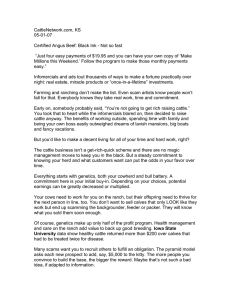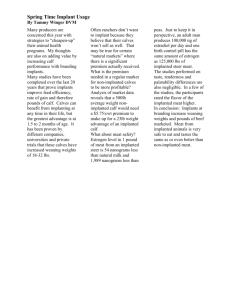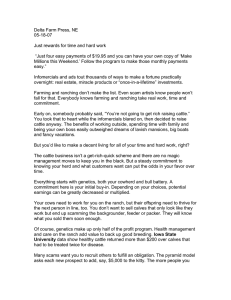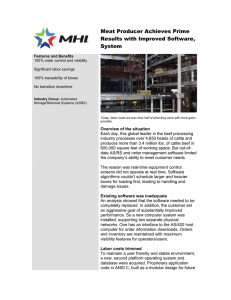Just the Facts: Growth Promotants in Beef Cattle Dr. Jacob R. Segers
advertisement
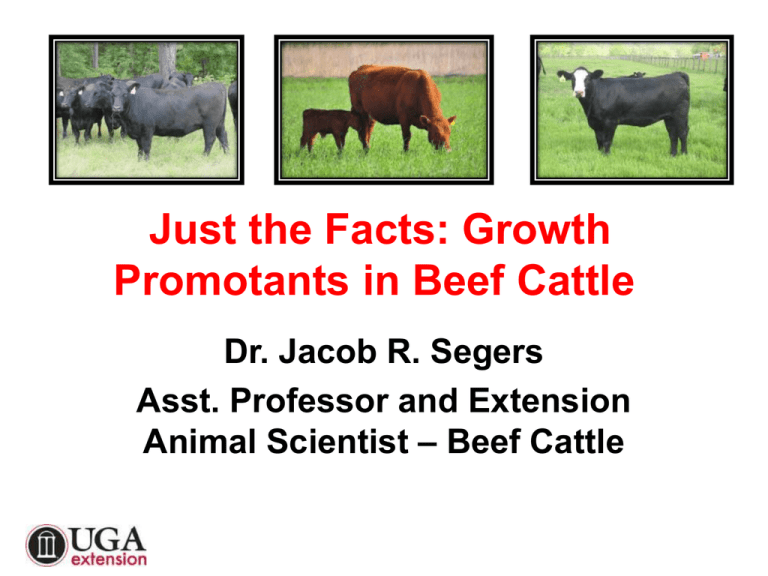
Just the Facts: Growth Promotants in Beef Cattle Dr. Jacob R. Segers Asst. Professor and Extension Animal Scientist – Beef Cattle Thank You to Our Sponsors • Allflex USA/Destron Fearing – Mr. Steve Blackburn • Anipro Xtraformance Feeds – Mr. Phillip Crawford • Boehringer Ingelheim Vetmedica, Inc. – Ms. Christy Bryan and Mr. Randy Fordham • Graham Livestock System – Mr. Stan Graham • Ivey’s Outdoor & Farm Supply, Inc – Mr. Kenny Sikes • Moseley Livestock Auctions, LLC – Mr.’s John, Trip, Will, & Joey Moseley • Zeeland Farm Services, Inc. – Mr. Ray Williams • Zinpro Performance Minerals – Mr. Charles Gay • Zoetis – Mr. Henry Jones Acknowledgements • Thank You – UGA-Tifton – Dr. Joe West – Department of Animal and Dairy Science – Dr. Keith Bertrand – Bull Test Management Team – Ms. Patsie Cannon, Mr. Mike Keeler, Mr. Jordan Gaylard, and Ms. Sandra McNeil – GCA – David Gazda, Josh White, Michelle Creamer, Bailey Toates, Suzanne Black, Will Bennet, Regional VP’s and Exec. Committee – Today’s Speakers: • • • • • • Dr. Glen Harris Dr. Dean Pringle Mr. Jary Douglas Dr. Dennis Hancock Dr. Lee Jones Dr. Curt Lacy – Mr. Doug and Dr. Mary Ellen Hicks and ABAC Cattlemen’s Association – Dr. Lawton Stewart, Dr. Ronnie Silcox, and Mr. Jason Duggin GROWTH PROMOTANTS • Compounds that produce a physiological response that results in improved efficiency and/or performance in meat animals • 2 Major Categories for Growing Cattle – Steroid Implants – Ionophores STEROID IMPLANTS What are Implants? • Small pellets that contain growth stimulating compounds (usually steroids) – Approved and regulated by the FDA • Implants work by causing an increase in the secretion of growth hormone and subsequent increase in muscle growth • Available for cattle multiple stages of development – Nursing calves – Stocker cattle – Feedlot cattle Overview of Implants • Growth implants are widely used in the beef cattle industry – 70% to 80% of all feedlots • In general they improve average daily gain by 5% to 15% and feed efficiency by 5% to 10% – One of the most economically justifiable practices available • Implanting generates a minimum of $10 return for every $1 invested • More revenue/$ invested than any other practice • Cattle that are not implanted must sell at a premium to generate the same net profit as implanted cattle • Technology only utilized by about 1/3 of cow/calf producers Types of Implants • Estrogenic vs Androgenic – Estrogenic – action is mediated by female hormonal pathways (estrodiol, progesterone) – Androgenic – action is mediated by male hormonal pathways (testosterone) • Synthetic hormones – Zeranol (Ralgro) is estrogenic in action – Trenbolone acetate (TBA; Revalor®, Component®, Synovex H®) is androgenic in action Only 1 FDA-approved location for implantation Response Differences • Sex: Steers>Heifers – Paradox: Greatest response observed with TBA in Heifers and with Estrogen in Steers – Implants are not approved for use with bulls • Maturity: Growing>Finishing>Suckling • Gain: Greatest response occurs when ADG greater than 1 lb. per day. Implanting Nursing Calves • All terminal calves should be implanted • Implanted calves improved ADG during nursing by 4-6% increased WW by 14.5 – 29.6 lb • Implants are effective for 90120 days – When calf prices are high, implanting at birth and 90 days prior to weaning may be cost effective – Implant type will impact effectiveness of second implant (Zeranol > Estrodiol) Implanting Nursing Calves • Calves must have adequate condition to maximize effects of implanting – Maximal effect seen in calves nursing heavy milking cows or those that are creep fed – Most effective in spring-born calves that can be due to nutrient availability from sources other than the cow – Also effective in fall-born fed with adequate creep feed or access to cool season annuals Implanting Stocker Cattle • Stocker cattle respond with greater performance improvements than nursing calves • Implanting stocker calves can improve ADG by 10 – 20 percent • Can be implanted every 90 – 100 days dependent upon label restrictions • Increasing nutrition will increase effectiveness Daily gain response to use of an implant, energy supplement, and ionophore Treatment Daily Gain, lb Growth Response, % Control 1.22 ------ Grain Supplement, 2lb/day 1.35 10.7 Compudose 1.39 13.9 Supplement + Rumensin 1.45 18.9 Compudose + Supplement + Rumensin 1.72 41.0 aCompudose® bRumensin® Adapted from Kuhl et al., 1997 Feedlot Implant Strategy • Some feedlots prefer to change implants during the feeding period • Most implants are effective for 70 to 100 days except for Compudose (140 to 170 days) • Choice of implant may depend on various factors including length of time on feed Risk Assessment • STEROID RESIDUES! HOW DARE YOU? • DR. OZ SAID MY 6 YR OLD WILL HAVE CHEST HAIR!!! – Diethylstilbestrol (DES) was first implant introduced, but removed from market because residues were found in lab rats fed extreme does of DES – When DES residues were detected, they were found in liver tissue • If one consumed liver that contained high levels of DES, one would need to consume 5,500 lbs of liver daily to reach the daily therapeutic threshold (5 mg) for humans – Therapeutic threshold-minimal concentration required to trigger a physiological response • We need to be realistic in risk assessment Estrogen is Synthesized by Humans Age Group Children Adult Man Non-pregnant Woman Pregnant Woman Estrogen Amounts (ng/d) 40,000 100,000 5,000,000 90,000,000 Estrogen produced by Synovex-S Implant (120d) = 120,000 ng/d Estrogen consumed from 1 lb of implanted beef = 11 ng ESTROGEN CONCENTRATION IN FOOD Food (500g≈1 lb) Non-Implanted Beef Implanted Beef Beef from Pregnant Cow Ice Cream Cabbage Eggs Soybean Oil Estrogen Amounts (ng) 8 11 700 3,000 12,000 17,500 1,000,000 WHAT ABOUT QUALITY? Can be diminished if implanting schedule is not managed with growth stage Ionophores What makes a rumen work? MICROBES Acetate Energy (Volatile Fatty Acids) Propionate Cellulose is the major energy source for SE cattle = Increased Acetate Production RUMEN Sources of Energy Fiber Starch ↑Propionate SMALL INTESTINE ↑ Acetate Ionophore Overview • Antibiotics added to feed – Do not have a therapeutic function in humans • Originally developed as coccidiostats for poultry • Increase efficiency and gain in beef cattle • Decrease incidence of bloat , acidosis, and cyclic feeding patterns • Commonly marketed as monensin (Rumensin®), lasalocid (Bovatec®), and laidlomycin (Cattlyst®) How Ionophores Work • Shift rumen fermentation patterns – Propionate > Acetate and Butyrate – Propionate is more easily utilized for productive purposes by cattle • Decrease protein degradation in rumen – Increase bypass protein Ionophores interupt ion flow across the cell membrane of gram-positive bacteria Advantages of Ionophores • Increased propionate and decreased acetate and methane improve efficiency and gain – 76% increase in propionate – 30% decrease in methane production • Decreasing gram-positive bacteria decreases incidence of acidosis and bloat Common Ionophores • Rumensin® (monensin) – Most popular – Used predominantly in feedlots, but will work in forage systems – Works by decreasing intake while maintaining gain • Subdues acidosis • Bovatec® (lasalocid) – Used predominantly in forage-based systems, but will work in the feedlot – Increased gain while maintaining or increasing intake • Both select for increased ruminal propionate production Cost Benefits • Ionophores vary in cost from $6.00 -$ 8.00/lb in its raw state. • Rumensin® is most popular – 200mg/hd/day – $0.012/hd/day • Research suggests that monensin yields 6-14% increase in ADG = 12:1 benefit to cost ratio (Hutjens, 1991) Meat Quality Effects • No known carcass detriments associated with use of ionophores • Increasing propionate concentration increases gluconeogenesis – Glucose is primary precursor for marbling development (Smith and Crouse, 1984) ? ? ? ?
